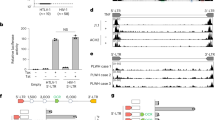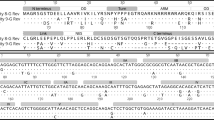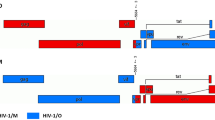Abstract
Two evolutionarily distinct families of human retroviruses, the human immunodeficiency viruses (HIV) and the human T-cell leukaemia viruses (HTLV), have been defined (reviewed in ref. 1). Although these virus groups share tropism for human CD4+ T cells, they differ markedly in primary sequence, genetic organization and disease association (AIDS versus adult T-cell leukaemia), but show similar general strategies for the regulation of viral gene expression. Each encodes a protein able to trans-activate transcription from the homologous viral long terminal repeat (tat in HIV2,3, tax in HTLV4–7), although these proteins act by different mechanisms and do not appear to be interchangeable8–11. Each virus also produces a second trans-acting protein that induces the expression of the unspliced messenger RNAs encoding the viral structural proteins (rev in HIV12,13 and rex in HTLV14). Here we show that the rex protein of HTLV-I can functionally replace the rev protein of HIV-1 in transient expression assays. This genetic complementation by rex is adequate for the rescue of a replication-defective rev mutant of HIV-1. This unexpected shared function between the structurally distinct rex and rev proteins emphasizes the importance of this highly conserved pathway for the regulation of human retrovirus gene expression.
This is a preview of subscription content, access via your institution
Access options
Subscribe to this journal
Receive 51 print issues and online access
$199.00 per year
only $3.90 per issue
Buy this article
- Purchase on SpringerLink
- Instant access to full article PDF
Prices may be subject to local taxes which are calculated during checkout
Similar content being viewed by others
References
Wong-Staal, F. & Gallo, R. C. Nature 309, 640–642 (1985).
Sodroski, J. G. et al. Science 227, 171–173 (1985).
Arya, S. K., Guo, C., Josephs, S. F. & Wong-Staal, F. Science 229, 69–73 (1985).
Sodroski, J. G., Rosen, C. A. & Haseltine, W. A. Science 225, 381–385 (1984).
Fujisawa, J., Seiki, M., Kiyokawa, T. & Yoshida, M. Proc. natn. Acad. Sci. U.S.A. 82, 2277–2281 (1985).
Cann, A. J., Rosenblatt, J. D., Wachsman, W., Shah, N. P. & Chen, I. S. Y. Nature 318, 571–574 (1985).
Felber, B. K., Paskalis, H., Kleinman-Ewing, C., Wong-Staal, F. & Pavlakis, G. N. Science 229, 675–678 (1985).
Rosen, C. A. et al. Nature 319, 555–559 (1986).
Cullen, B. R. Cell 46, 973–982 (1986).
Chen, I. S. Y. Cell 47, 1–2 (1986).
Kao, S. Y., Calman, A. F., Luciw, P. A. & Peterlin, B. M. Nature 330, 489–493 (1987).
Sodroski, J. G. et al. Nature 321, 412–417 (1986).
Feinberg, M. B., Jarrett, R. F., Aldovini, A., Gallo, R. C. & Wong-Staal, F. Cell 46, 807–817 (1986).
Hidaka, M., Inoue, J., Yoshida, M. & Seiki, M. EMBO J. 7, 519–523 (1988).
Knight, D. M., Flomerfelt, F. A. & Ghrayeb, J. Science 236, 837–840 (1987).
Rosenblatt, J. D. et al. Science 240, 916–919 (1988).
Yoshida, M. & Seiki, M. A. Rev. Immun. 5, 541–549 (1987).
Malim, M. H., Hauber, J., Fenrick, R. & Cullen, B. R. Nature 335, 181–183 (1988).
Hauber, J., Bouvier, M., Malim, M. H. & Cullen, B. R. J. Virol. (in the press).
Kiyokawa, T. et al. Proc. natn. Acad. Sci. U.S.A. 82, 8359–8363 (1985).
Cullen, B. R. et al. J. Virol. 62, 2498–2501 (1988).
Wain-Hobson, S., Alizon, M. & Montagnier, L. Nature 313, 743 (1985).
Chou, I.-M. et al. Nature 31, 366–368 (1985).
Gonda, M. A. et al. Proc. natn. Acad. Sci. U.S.A. 83, 4007–4011 (1986).
Sagata, N. et al. Proc. natn. Acad. Sci. U.S.A. 82, 677–681 (1985).
McClure, M. A., Johnson, M. S., Feng, D. F. & Doolittle, R. F. Proc. natn. Acad. Sci. U.S.A. 85, 2469–2473 (1988).
Gallo, R. C., Wong-Staal, F., Montagnier, L., Haseltine, W. A. & Yoshida, M. Nature 333, 504 (1988).
Cullen, B. R. Meth. Enzym. 152, 684–704 (1987).
Greenberg, M. E. & Ziff, E. B. Nature 311, 433–438 (1984).
Poiesz, B. et al. Proc. natn. Acad. Sci. U.S.A. 77, 7415–7419 (1980).
Veronese, F. D. et al. Proc. natn. Acad. Sci. U.S.A. 82, 5199–5203 (1985).
Author information
Authors and Affiliations
Rights and permissions
About this article
Cite this article
Rimsky, L., Hauber, J., Dukovich, M. et al. Functional replacement of the HIV-1 rev protein by the HTLV-1 rex protein. Nature 335, 738–740 (1988). https://doi.org/10.1038/335738a0
Received:
Accepted:
Issue date:
DOI: https://doi.org/10.1038/335738a0
This article is cited by
-
A novel positive feedback-loop between the HTLV-1 oncoprotein Tax and NF-κB activity in T-cells
Retrovirology (2020)
-
Identification of a homogenous structural basis for oligomerization by retroviral Rev-like proteins
Retrovirology (2017)
-
HIV infection and HERV expression: a review
Retrovirology (2012)



